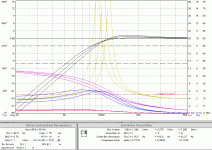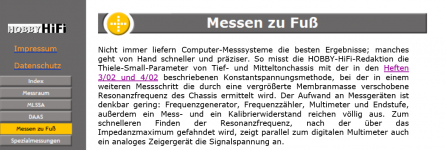...initial box sizing was way off because the data sheet specs are BS.
George
Now you understand that speaker units are not nuts & bolts, their specs change with climate conditions, age, different materials introduced in production line, etc. You are wasting your time searching for a better way of measuring TSP. I have got Audiomatica Clio, one of the best performing measurement systems in their own time, the 90's of the past century, and I also measure this kind of changes, with Scan Speak, Visaton, Peerless...only Focal and Dynaudio were spot on.
...before going on with your discussion about measurement software /systems have a look at this Klippel paper:
https://www.klippel.de/fileadmin/kl...N_42_Tolerances_of_Resonance_Frequency_fs.pdf
Regards
Heinrich
Thank you, this is interesting. Unfortunately it only prolongs the dilemma of figuring out how to determine a box volume for two drivers sitting on my work bench with measured TS parameters that are off by as much as 50% from the data sheet. I still don’t know if my measurements are of any value or if I should even be considering doing my own measurements given that I can’t spen $5k for this process. Since this thread has enlightened me that measurement condition, order, calculations, etc all affect the result I will restate my earlier question:
Some of you have recommended solutions for raw driver TS parameter measurement like CLIO and Smith & Larson WT2. Do any of these also provide detailed instructions on how to measure to get proper results (proper order, how to do added mass for Vas, warm up driver, etc)? I find for instance that my added mass process is not repeatable so I have little confidence in the results.
Thanks,
George
Oh I think I need more sleep, now I see it. You switched drivers
Can you post the actual impedance plots from the T/S measurement run?
Tony.
Sorry about the confusion. I started pulling drivers to see if I have a consistent problem and I did wind up doing the burn in experiment with a different one.
This is an Aura NS3-193-8A that I bought new that sat around for a few months but was not used. I played music material through it for 24 hours this week to burn it in. Here are the data sheet specs (A), the initial TS measurements with DATS2 (B), and TS measurements after 24 hours of burn in (C). Also attached is the impedance plot of today's 24 hr burn in measurement as well as the data sheet. I did not include Vas because I can't get consistent measurements on this parameter using added weight:
Aura NS3-193-8A:
--------A------B-------C
Re---7.60---7.72---7.77
Fs------80---123----116
Qts---0.67--0.87---0.88
Qes---0.73--1.08---1.06
Qms--8.00---4.49--5.08
Thanks,
George
Attachments
Last edited:
T/S are curves, not scalars.
Different measuring kit pulls the number from a different part of the curve, so measures can be significantly different. Also whether the sw estimates the parameters or actually measures them. Short of the pro stuff the factories use (ie $5k-ish), Smith+Larson Woofer Tester 2 is probably the best short of them.
I always start with the factory numbers,i have rarely had to redo a box. Also keep in mind that depending on the manufacturer parameters will vary from plus-minus 5% to plus-minus 20& or more.
I use S+L for driver matching and unknown drivers.
dave
Smith & Larson WT2 looks interesting as they claim very good accuracy and repeatability. One thing that I have learned here is that measurement techniques and conditions matter a lot. Do they include good instructions on the process to be able to achieve their claimed results?
Thanks,
George
Last edited:
Thanks. I suspect that in the case of this small driver that I may have problems with the light added mass weight vibrating under test. In you tube videos guys are measuring giant woofers with water bottles attached to rolls of tape. I have layers of post it notes on mine, measuring them with a sensitive gram scale. Do I need to attach my weight to the surround with double sided tape or something?
Thanks,
George
Do they include good instructions on the process to be able to achieve their claimed results?
It is pretty simple. I talked with one of the guys to get things set up. The sw does way more than i use.
Unlike many sw measuring packages it actually goes looking for the key T/S base numbers instead of estimating them from an impedance curve. It comes with its own USB connected current amplifier. It means the impedance curves are not always pretty but they are relatively repeatable and the closest i have gotten to factory.
The Aura NS3 goes nicely into a small sealed box.
dave
Attachments
On the added weight, for small drivers I simply use bluetac rolled into a snake which I place around the perimeter of the dust cap. Be careful pressing it on, you want it to stick evenly but not push in the cone too far.
Your graph for the NS3 looks clean but the impedance peak is quite a bit lower than the manufacturers curve. The NS3 has a very high QMS which means that the spider and surround are very compliant, I suspect that it still hasn't fully broken in. I'd try the sine wave at 80hz for 10 minutes at close to X-Max. Let it cool and then measure again.
Here is the page for measuring T/S params with REW Thiele Small Parameters It has inputs for air temp and air pressure, so that helps with some of the environmental considerations.
Tony.
Your graph for the NS3 looks clean but the impedance peak is quite a bit lower than the manufacturers curve. The NS3 has a very high QMS which means that the spider and surround are very compliant, I suspect that it still hasn't fully broken in. I'd try the sine wave at 80hz for 10 minutes at close to X-Max. Let it cool and then measure again.
Here is the page for measuring T/S params with REW Thiele Small Parameters It has inputs for air temp and air pressure, so that helps with some of the environmental considerations.
Tony.
Now you understand that speaker units are not nuts & bolts, their specs change with climate conditions, age, different materials introduced in production line, etc. You are wasting your time searching for a better way of measuring TSP. I have got Audiomatica Clio, one of the best performing measurement systems in their own time, the 90's of the past century, and I also measure this kind of changes, with Scan Speak, Visaton, Peerless...only Focal and Dynaudio were spot on.
So do you measure the actual drivers and trust your data to design the enclosure even if the actual measurements are very different from the data sheet like my numbers?
Thanks,
George
You may want to have a look at this post to get an idea of why I am recommending trying REW https://www.diyaudio.com/forums/ful...2mnrx25-4-range-build-thread.html#post3089713 I've been there done that 
The SB driver in questions datasheet is here 4" SB12MNRX25-4 :: SB Acoustics
Tony.
The SB driver in questions datasheet is here 4" SB12MNRX25-4 :: SB Acoustics
Tony.
There is another and probably last resort to acquiring the lowest possible driver Fs. The German Hobby HiFi magazine states that not always is the elaborate computer measurement system the best way to measure specs, like TSP, so they do it manually with a signal generator, multimeter, amplifier, a measurement resistor, and a calibration resistor. They have explicitly said more than a couple of times when readers were wondering why their measurement appeared differently from the ones in magazine, and they said it was because of the way they measure, as described above (constant voltage method).
Attachments
On the added weight, for small drivers I simply use bluetac rolled into a snake which I place around the perimeter of the dust cap. Be careful pressing it on, you want it to stick evenly but not push in the cone too far.
Your graph for the NS3 looks clean but the impedance peak is quite a bit lower than the manufacturers curve. The NS3 has a very high QMS which means that the spider and surround are very compliant, I suspect that it still hasn't fully broken in. I'd try the sine wave at 80hz for 10 minutes at close to X-Max. Let it cool and then measure again.
Here is the page for measuring T/S params with REW Thiele Small Parameters It has inputs for air temp and air pressure, so that helps with some of the environmental considerations.
Tony.
I have just reviewed the TS measurement process in REW. Could you please outline the impedance measurement circuit that you use as there are a few different approaches (sound card only, separate amplifier, etc)?
Thanks,
George
There is another and probably last resort to acquiring the lowest possible driver Fs. The German Hobby HiFi magazine states that not always is the elaborate computer measurement system the best way to measure specs, like TSP, so they do it manually with a signal generator, multimeter, amplifier, a measurement resistor, and a calibration resistor. They have explicitly said more than a couple of times when readers were wondering why their measurement appeared differently from the ones in magazine, and they said it was because of the way they measure, as described above (constant voltage method).
I tried to find an article from this magazine discussing how to measure TS parameters but I cant find anything. Also I can not read German. Do you have a link?
Thanks,
George
- Status
- This old topic is closed. If you want to reopen this topic, contact a moderator using the "Report Post" button.
- Home
- Loudspeakers
- Multi-Way
- Measuring driver parameters vs the data sheet values

